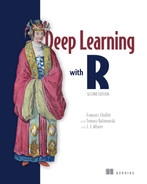about this book
This book was written for anyone who wishes to explore deep learning from scratch or broaden their understanding of deep learning. Whether you’re a practicing machine learning engineer, a data scientist, or a college student, you’ll find value in these pages.
You’ll explore deep learning in an approachable way—starting simply, then working up to state-of-the-art techniques. You’ll find that this book strikes a balance between intuition, theory, and hands-on practice. It avoids mathematical notation, preferring instead to explain the core ideas of machine learning and deep learning via detailed code snippets and intuitive mental models. You’ll learn from abundant code examples that include extensive commentary, practical recommendations, and simple high-level explanations of everything you need to know to start using deep learning to solve concrete problems.
The code examples use the deep learning framework Keras, with TensorFlow 2 as its numerical engine. They demonstrate modern Keras and TensorFlow 2 best practices as of 2022.
After reading this book, you’ll have a solid understand of what deep learning is, when it’s applicable, and what its limitations are. You’ll be familiar with the standard workflow for approaching and solving machine learning problems, and you’ll know how to address commonly encountered issues. You’ll be able to use Keras to tackle real-world problems ranging from computer vision to natural language processing: image classification, image segmentation, time-series forecasting, text classification, machine translation, text generation, and more.
Who should read this book?
This book is written for people with R programming experience who want to get started with machine learning and deep learning. But this book can also be valuable to many different types of readers:
- If you’re a data scientist familiar with machine learning, this book will provide you with a solid, practical introduction to deep learning, the fastest growing and most significant subfield of machine learning.
- If you’re a deep learning researcher or practitioner looking to get started with the Keras framework, you’ll find this book to be the ideal Keras crash course.
- If you’re a graduate student studying deep learning in a formal setting, you’ll find this book to be a practical complement to your education, helping you build intuition around the behavior of deep neural networks and familiarizing you with key best practices.
Even technically-minded people who don’t code regularly will find this book useful as an introduction to both basic and advanced deep learning concepts.
To understand the code examples, you’ll need reasonable R proficiency. You don’t need previous experience with machine learning or deep learning: this book covers, from scratch, all the necessary basics. You don’t need an advanced mathematics background, either—high school–level mathematics should suffice to follow along.
About the code
This book contains many examples of source code both in numbered listings and in line with normal text. In both cases, source code is formatted in a fixed-width font like this to separate it from ordinary text. Output from running code is similarly formatted in fixed-width font, but is also adorned with a vertical gray bar on the left. Throughout the book you’ll find code and code outputs interleaved like this:
print("R is awesome!")
[1] "R is awesome!"
In many cases, the original source code has been reformatted; we’ve added line breaks and reworked indentation to accommodate the available page space in the book. In rare cases, even this was not enough, and listings include line-continuation markers (![]() ). Additionally, comments in the source code have often been removed from the listings when the code is described in the text. Code annotations accompany many of the listings, highlighting important concepts.
). Additionally, comments in the source code have often been removed from the listings when the code is described in the text. Code annotations accompany many of the listings, highlighting important concepts.
You can get executable snippets of code from the liveBook (online) version of this book at https://livebook.manning.com/book/deep-learning-with-r-second-edition/, and as R scripts on GitHub at https://github.com/t-kalinowski/deep-learning-with-R-2nd-edition-code.
liveBook discussion forum
Purchase of Deep Learning with R, Second Edition, includes free access to liveBook, Manning’s online reading platform. Using liveBook’s exclusive discussion features, you can attach comments to the book globally or to specific sections or paragraphs. It’s a snap to make notes for yourself, ask and answer technical questions, and receive help from the author and other users. To access the forum, go to at https://livebook.manning.com/book/deep-learning-with-r-second-edition/. You can also learn more about Manning’s forums and the rules of conduct at https://livebook.manning.com/discussion.
Manning’s commitment to our readers is to provide a venue where a meaningful dialogue between individual readers and between readers and the author can take place. It is not a commitment to any specific amount of participation on the part of the author, whose contribution to the forum remains voluntary (and unpaid). We suggest you try asking the author some challenging questions lest their interest stray! The forum and the archives of previous discussions will be accessible from the publisher’s website as long as the book is in print.
About the cover illustration
The figure on the cover of Deep Learning with R, Second Edition, “Habit of a Chinese Lady in 1700,” is taken from a book by Thomas Jefferys, published between 1757 and 1772.
In those days, it was easy to identify where people lived and what their trade or station in life was just by their dress. Manning celebrates the inventiveness and initiative of the computer business with book covers based on the rich diversity of regional culture centuries ago, brought back to life by pictures from collections such as this one.
